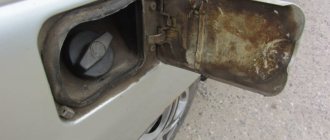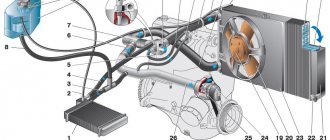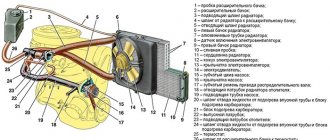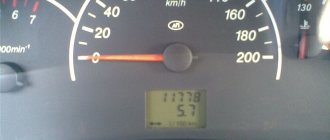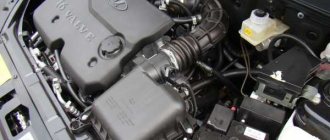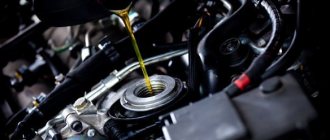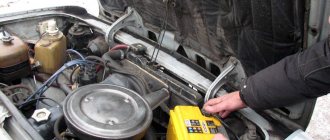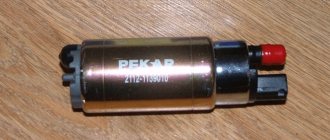Signs of breakdown
There are several situations in which the pump or its components can be at fault. This will definitely have to be checked. Otherwise, you can spend a lot of money buying and installing a new fuel pump, but in the end it turns out that the problem is completely different.
- The engine will not start. This is not a clear sign of problems with the pump, but still. Therefore, first check the condition of the spark plugs, the presence of a spark, and the absence of traces of oil on them. Also check the electronic control unit.
- Pressure inside the fuel system. If the pump is operating normally, it will create a pressure of 3.2 bar. Depending on the type of engine in your VAZ 2114, the characteristics may differ slightly: For a 1.5-liter engine, the optimal values are 285-325 kPa;
- For a 1.6-liter engine, these characteristics in optimal operating mode will range from 375 to 390 kPa.
There is no signal that is not sent to the pump. This happens when you turn the ignition key. During normal operation, the pump begins to vibrate slightly when turning the key. If this does not happen, be sure to check the wiring. Troubles the power unit. This is also not an ideal sign of a fuel pump failure. But you still have to check. It is likely that the culprit in this situation will be the pump. The engine jerks. Moreover, this happens at low speeds or even at start. There are two possible reasons for the situation - a breakdown of the pump itself or a problem with the fuel pump grid, which will have to be replaced.
New and old coarse filter Many people purchase the entire fuel module assembly at once, which includes a filter, sensor, float, intake chamber and the pump itself. Such a purchase will cost approximately 3,000 rubles. It is much more profitable and practical to buy a separate pump, which costs up to 1000 rubles. This is due to the fact that when the pump fails, the remaining elements almost always remain intact and are fully suitable for further use.
Gas tank repair
Repairing a fuel tank is usually not very difficult. Much here depends on the nature of the damage and the skills of the car owner. Small holes in the case can simply be soldered, but large damage will require the use of a welding machine.
The tank itself does not always need welding or repair. On VAZ 2108/09/14/15 vehicles, the tank fastening elements or its components (for example, the neck or studs) often fail. Such malfunctions need to be eliminated urgently - the safety of fuel storage in the tank is largely determined by its fastening, position relative to the body axis and tightness.
Required tools and accessories
Removing the gas tank is carried out using a standard set of tools: wrenches of different sizes, a screwdriver and a hammer in case any element is difficult to dismantle.
To wash, clean and repair the tank you will need:
container for draining fuel;
tire pump for supplying compressed air;
hose connected to a hot water supply;
7.13 Removing, repairing and replacing the fuel tank
Removing, repairing and replacing the fuel tank
Before beginning this procedure, see the warning given at the end of the General Information and Precautions .
Read:
Before you begin removing the fuel tank , it is advisable to first empty all the fuel from the tank. Since the gas tank does not have a drain plug, the operation can be started when the tank is almost empty. If it is not possible to suck out the fuel using a siphon or hand pump, proceed as follows. Remove the luggage compartment floor panel and fuel pump
, then disconnect the wires from the pump.
Disconnect the supply hose from the pump and connect a plastic tube using a union nut of a suitable size. How to remove the VAZ heater motor (heater motor) - youtube. Place the free end of the plastic tube into a container of suitable volume. Remove fuses 14 and 22 from the fuse box (see Chapter Electrical system ), then, connecting the two terminals with a wire, start the fuel pump. Pump out all fuel from the tank, then disconnect the components. Place fuel in a safe place, following the precautions given in Section General Information and Precautions .
VAZ 2114 tank volume: finding out the real numbers
Self-repair and replacement of the pump of VAZ 2110/11/12 cars
Before we look at the main question - how much volume the VAZ 2114 tank holds, let’s look at the main technical characteristics of this car.
Technical characteristics of the VAZ 2114
Its engine parameters are as follows:
- working volume - 1499 cm3;
- total power - 77 hp;
- maximum rotation speed - 5200 min-1;
- maximum torque - 116 N/m.
In turn, the main operating parameters of the VAZ 2114 car look like:
- acceleration time from 0 to 100 km/h - 14 s;
- maximum possible speed - 157 km/h;
- fuel consumption in urban conditions (per 100 km) - 9.9 l;
- fuel consumption on a suburban highway (per 100 km) - 6.2 l;
- fuel consumption when traveling in mixed conditions (per 100 km) - 7.5 liters.
Now consider the main weight and dimensions of the car:
- total length - 4122 mm;
- full width - 1650 mm;
- height - 1422 mm;
- ground clearance - 165 mm;
- wheelbase size - 2460 mm;
- front track - 1400 mm;
- rear track - 1370 mm;
- weight (curb) - 985 kg;
- weight (total) - 1410 kg;
- fuel tank volume (full) - 43 l.
As you can see from the table above, the gas tank on the VAZ 2114 holds exactly 43 liters. Is this really so? Let’s look at it below.
Actual tank volume on the 14th model
As mentioned, the manufacturer claims that the volume of the 2114 tank is 43 liters (in some cases you can find a figure of 42.5 liters). And this figure is indeed very close to reality.
At the same time, it is worth considering a number of facts that can significantly affect capacity:
- Errors in the manufacture of the tank.
- Time of year and temperature.
- Fuel system volume.
The first of these factors is usually insignificant. But, as practice shows, sometimes the difference in the volumes of two identical tanks can reach (as a result of low production accuracy) 2 liters. Thus, on some machines the total volume can reach 45 liters (which is extremely rare).
This should also include the difference in weather conditions. In cold weather, the fuel contracts, and in warm weather, it expands. This factor also affects how many liters the tank on a VAZ 2114 can hold (if we take into account the full volume of gasoline that can fit in hot summers and winter frosts, the difference can reach 1.5 liters).
Well, finally, you should remember that the fuel system itself also holds a certain amount of fuel. On average, when the tank is completely empty, up to 2 liters of gasoline can remain in it. As a result of this number of features, the amount of fuel contained in the tank may differ from that declared by the manufacturer, either more or less.
If at a gas station you managed to fill 50 liters of fuel into an almost empty tank, then this can become a good reason to complain about the accuracy of the filling device and the operation of the station itself. Such a large difference in volumes cannot be attributed to any of the above errors.
It is also worth noting that if the vehicle is operated incorrectly and refueled with low-quality fuel, sediment can accumulate at the bottom of the tank, which over time can (albeit insignificantly) reduce its volume. In order to avoid such a situation, the tank should be inspected every few years.
If the warning light on the panel lights up, it means you can fill the tank with up to 35 liters of fuel without fear of it overflowing.
Consumption and travel distance
If we take into account the volume of the VAZ 2114 tank and the data on gasoline consumption (given in the table above), we can draw the following conclusions about the possible travel range.
When driving at a constant speed of 90 km/h, the maximum range can be almost 700 km without additional refueling.
Fuel system VAZ 2114
When traveling in the so-called “mixed” city/highway mode, consumption will increase, which means the range will decrease (up to 640 km).
How many liters of tank is there for a VAZ 2115 car?
How to measure how many liters of fuel are in the tank?
Replacing the fuel tank of a VAZ 2109
1. Start the car and time how long it takes for it to stall, knowing the fuel consumption for such a case.
2. Drive the car and see after how many kilometers it stalls, knowing the consumption per km.
3. Drain the gasoline and measure manually.
4. Weigh the car, which only contains gasoline, and compare it with the weight of the empty car in the passport.
5. Look at the sensor display.
Nikita Olekhno, graduate student of the Faculty of Physics and Technology
How long does it take to change antifreeze on a VAZ 2115?
The coolant should be replaced every sixty thousand kilometers of the car, or you should look at the color of the fluid, and after the fluid changes to a reddish color, change it.
What is the fuel consumption per 100 km of the Lada Largus?
For Lada Largus, fuel consumption per 100 km according to the passport is 10 liters. And this is an urban cycle, not a mixed cycle or anything else. We're talking about a 16 valve here.
How many cans of raptr will it take to paint a VAZ 21 15?
Three liters, at a minimum, unless there are some difficult areas where more layers will need to be applied. If you are doing it for the first time and are in doubt, then it is better to take four liters so that you have a reserve in case of an unforeseen situation.
How many liters are in the truck's gas tank?
It all depends on the make of the car. The maximum fuel tank volume at the moment is 1500 liters + it can tow a refrigerated semi-trailer, which is another 200 liters. If we take the average volume of a fuel tank, it is about 500 liters.
How much oil is in the VAZ 2114 gearbox?
According to official data, the transmission volume in VAZ 2114 cars is 3.5 liters. But in practice, the amount of fluid to be replaced can be 3.3 liters. This is due to the fact that when the used lubricant is drained, a certain amount of oil remains in the gearbox on the pulleys and walls.
Installation location of the fuel tank VAZ 2114
On cars of the Lada line, the fuel location element is installed under the bottom of the car.
The location is not accidental; first of all, it is due to safety reasons (preventing deformation and ignition of fuel). The volume of the VAZ 2114 gas tank is 43 liters, which corresponds to approximately 550 - 560 kilometers with a normal, smooth driving style (without fast acceleration). The filler neck is located on the rear wing of the VAZ on the passenger side.
Common problems and their solutions
If we talk about the most important problems, “sores” that are inherent in fuel storage devices, the most common are the following: - fuel leaks; - the appearance of excess pressure inside.
Loss of gasoline can be caused by the following reasons:
- Formation of a crack due to corrosion or deformation of the metal.
- One of the fuel hoses is bent or damaged.
- Leakage of hoses as a result of weak tightening of clamps at the joints.
Excessive, excessive pressure in the gas tank can be caused by a combination of the following reasons:
- high external temperatures;
- situations when the plastic cap of the VAZ 2114 gas tank does not have a hole for the release of gasoline vapors;
- poor functioning of the adsorber or its gas lines;
- lack of normal removal of excess fuel vapors.
Filling volumes and brands of oils and liquids Lada VAZ 2114
| Fuel tank volume Lada Vesta Filling/lubrication point | Filling volume, liters | Name of oil/liquid |
| Fuel tank | 42,5 | Motor gasoline AI-91, AI-93, AI-95 |
| Engine cooling system including interior heating system | 7,8 | Coolant “Tosol AM”, “Tosol A-40M”, “OZhK LENA”, “LENA-40”, “SPECTROL ANTI-FREEZE”, “AGIP ANTIFREEZE EXTRA”, “Glisantin G 03”. |
| Engine lubrication system including oil filter | 3,5 | Motor oils "LUKOIL ARCTIC" (5W-40, 5W-30; SG/CD); “YAR-MARKA SUPER” (5W-40, 5W-30; SG/CD); "ESSO ULTRA" (10W-40; SJ/SH/CD); "ESSO UNIFLO" (15W-40; SJ/SH/CD). |
| Gearbox housing | 3,3 | Transmission oils (classification according to SAE; API) “REXOL T” (80W-85; GL-4); "VOLNEZ TM-5-12" (80W-85) |
| Hydraulic brake system | 0,435 | Brake fluid "ROSA"; "ROSA-3"; "ROSA-DOT-4"; "SPECTROL DISK BRAKE FLUID" DOT-4; "AGIP BRAKE FLUID" DOT-4; "HYDRAULAN 408" DOT-4 |
| Hydraulic front suspension strut | 0,31 | Liquid for shock absorbers GRZh-12 |
| Rear suspension shock absorber | 0,25 | |
| Windshield and headlight washer reservoir | 4,2 | A mixture of water with special liquid “OBZOR”, “GLASSOL” or “Window washer fluid “ASPECT” |
| Starter drive drive ring Steering rod joints | Grease “Litol-24”, “AGIP GREASE 30”, “ESSO UNIREX No. 2”, “ESSO UNIREX No. 3”, “EXXON MEHRZWECKFETT” | |
| Front wheel drive hinges Door opening limiters | Lubricant “CV joint-4M”, “SPECTROL CV joint MoS2” Lubricant “CV joint-4” | |
| Steering gear housing Door, hood and trunk locks | Lubricant "FIOL-1" | |
| Front suspension ball joints | ShRB-4 grease | |
| Battery terminals and clamps Trunk lid torsion bars Door and trunk lid keyholes Fuel filler flap hinge and spring | VTV-1 auto lubricant in aerosol packaging | |
| Pressure regulator | Grease DT-1, Ditor |
What and how much to fill in LADA (VAZ) 2114 Samara
Fuel tank - 42.5 l. Fuel type: gasoline AI-92, AI-95.
The engine oil is changed every 10 thousand km. The permissible deviation is 1 - 2 thousand km. The oil filter must be changed at this mileage. The recommended fluids for VAZ 2114 power plants are:
- LUKOIL ARCTIC (5W-40, 5W-30; SG/CD);
- “YAR-MARKA SUPER” (5W-40, 5W-30; SG/CD);
- "ESSO ULTRA" (10W-40; SJ/SH/CD);
- "ESSO UNIFLO" (15W-40; SJ/SH/CD).
They are also used for the engine crankcase.
Antifreeze must be changed every 60 thousand km or once every two years. The following coolants are recommended: “Tosol AM”, “Tosol A-40M”, “OZhK LENA”, “LENA-40”, “SPECTROL ANTI-FREEZE”, “AGIP ANTIFREEZE EXTRA”, “Glisantin G 03”. Refill volume – 7.8 l.
The car's operating instructions indicate the frequency of changing transmission oil - 30 thousand km. Suitable lubricants include:
- "REXOL T" (80W-85; GL-4);
- "VOLNEZ TM-5-12" (80W-85)
The lubrication of the rear axle housing is changed every 60 thousand km. At the same time, its level is periodically monitored - every 20 thousand km. If necessary, top up to the mark.
Brake fluid should be replaced once every two years regardless of the vehicle's mileage. Domestic DOT-4 or a foreign equivalent is recommended. For example, "ROSA"; "ROSA-3"; "ROSA-DOT-4"; "SPECTROL DISK BRAKE FLUID" DOT-4; "AGIP BRAKE FLUID" DOT-4; "HYDRAULAN 408" . Volume – 0.435 l.
1 295
What drive does the VAZ 2114 have?
The Lada 2114 Samara car is equipped with the following types of drive: Front-wheel drive (FF). Let's figure out which type of drive is best for a car.
There are only three types of drive. Front-wheel drive (FF) - when torque from the engine is transmitted only to the front wheels. All-wheel drive (4WD) - when the torque is distributed to the wheels of both the front and rear axles. And also Rear-wheel drive (FR), in its case, all the engine power is completely given to the two rear wheels.
Front-wheel drive is “safer”, front-wheel drive cars are easier to control and more predictable in motion, even a beginner can handle them. Therefore, most modern cars are equipped with front-wheel drive. In addition, it is inexpensive and requires less attention to maintain.
All-wheel drive can be called an advantage of any car. 4WD increases the vehicle's cross-country ability and allows its owner to feel confident both in winter on snow and ice, and in summer on sand and mud. However, you will have to pay for the pleasure, both in increased fuel consumption and in the price of the car itself - cars with a 4WD drive type are more expensive than other options.
As for rear-wheel drive, in the modern automotive industry it is equipped with either sports cars or budget SUVs.
Why is a subwoofer needed and what types of this speaker are known?
Whatever the subwoofer, its role is predetermined - it only complements the existing speaker system and is not needed for full bass reproduction. This means that without a subwoofer, some bass will play normally. For example, this applies to low frequencies of 80-200 Hz.
Installing a subwoofer in a VAZ 2114
There are two main types of subs: in a box and without it.
Let's start with case models:
- They are delivered in a box, the size (volume) of which may vary;
- In turn, such subwoofers can be either active or passive (see Which subwoofer is better: consider active or passive). The former initially have a built-in power amplifier along with a frequency divider or crossover, as it is also called. Subwoofer passive has neither an amplifier nor a crossover, but costs several times less than the first;
- The second type of subs comes without a housing. Such models crash into the rear parcel shelf or seat of the car.
Subwoofer in the wing of a VAZ 2114
For hatchbacks, such as the VAZ 2114, it is recommended to install an active subwoofer (see The best active subwoofers for cars and their review), since the shelf above the trunk will not prevent bass from penetrating into the body. The same applies to station wagons, but for sedans an open speaker embedded in the rear seat is more suitable.
tank volume, how much gasoline fits in the fuel tank?
The volume of the fuel tank in the car primarily determines the number of kilometers that can be driven without refueling. You need to know this if you are going on a long trip or spend a lot of time moving around the city. A car enthusiast needs to be able to plan his route in such a way as to be able to visit a gas station in a timely manner. Let's tell you what the volume of the tank is in a VAZ-2115 car.
Tank volume and why it changes
According to the technical documentation for the VAZ-2115, this car has a fuel tank with a nominal volume of 43 liters. However, its design feature is a long neck, into which you can pour another 2 to 5 liters. There is a fierce debate among car enthusiasts over how many liters can actually be placed in the tank of a standard “tag”. Many even believe that in cold weather a larger amount of fuel can be placed in the container than on a hot summer day.
In fact, the reason for the change in the holding volume of fuel is the deformation or stretching of the tank. If the surface of this spare car part has many dents, then its capacity will decrease. Over time, some car enthusiasts begin to notice that more gasoline is placed in the tank for refueling the car; this is due to the swelling of the tank.
It is unknown what the displacement will be in the latter case, but in practice, service station specialists have encountered tanks with a capacity of 50 liters (excluding the neck).
Problems of the VAZ-2115 fuel tank
The gasoline tank on the VAZ-2115, as in any other car model, is made of metal. This material tends to stretch and compress under the influence of external forces. This is far from the only problem with fuel capacity in this car. Most often, owners of this vehicle encounter the following problems:
- fuel leakage;
- incorrect operation of the sensor;
- design flaws.
The first and last faults are often related. The fact is that in carburetor models a separator is used. This device is necessary to collect gasoline vapors and condense them. After the vapor turns into liquid, it is drained back into the tank. Most VAZ-2115s are equipped with a plastic separator, which over time becomes covered with cracks, melts and becomes deformed. In such cases, it is necessary to replace it with a metal model, which is more resistant to external influences. The injector does not have such an element in its design.
Incorrect display of the fuel level in the tank can be caused by two reasons:
- If, after starting the engine, the instrument on the panel shows different values, then you need to look for a problem in the handbrake area. There is a ground wire running through it, the fastening of which may become loose when the vehicle is used. It is enough to tighten two bolts for the problem to disappear.
- After repairs, the gasoline consumption control lamp may come on prematurely. This is due to the fact that the float sensor located in the fuel container is triggered ahead of time. At the moment when the float drops to a certain level, the contacts close. It is enough to bend the limit switch slightly so that the closure occurs a little later.
Remember that all work on the fuel system must be carried out in compliance with safety rules.
How to remove the gas tank on a VAZ 2114
"Note! Before carrying out work related to dismantling the fuel tank, be sure to use up or manually drain all gasoline from the system.”
To successfully complete the event you will need: - an inspection hole, a lift or an overpass; — a special stand for holding the tank with height adjustment. If you don’t have one, you can use the help of a friend; — socket wrench set to “13”; - a flathead and Phillips head screwdriver.
After the preparations, follow these 10 simple steps:
- The first thing you need to do is disconnect the negative terminal from the battery.
- The second important step is to relieve pressure in the fuel system.
- Now is the time to disconnect all hoses, fittings that are connected and fed directly from the gas tank. To do this, do the following: - remove the rear seat in the car. Open the protective flap of the tank; if a large amount of dust has accumulated under the lid, remove it. Press the special plastic clips and disconnect the fuel lines from the fuel pump fittings; — disconnect the contact chip and carefully remove the fuel pump from the tank without damaging the pump float.
- Move under the bottom of the car. Locate the connection between the tank and the filler pipe hose. The elements are fastened using clamps that need to be loosened. We do the same with the gravity valve hose.
- Disconnect the hoses.
- At this stage, ensure that the fuel tank body is properly supported. To do this, place a special stand or ask someone to support the product with your hands.
- Holding the gasoline storage container, unscrew all the bolts securing the clamps. Move the clamps themselves to the side.
- Unhook the securing straps.
- Remove the tank (the brake pipe may prevent its removal; in this case, you just need to tilt the tank).
- This completes the replacement of the VAZ 2114 gas tank. Installation should be done in reverse order.
When starting the engine after reinstallation, be sure to check all joints and connections for leaks. If leaks are detected, tighten and tighten the clamps and hoses.
VAZ 2114 LADA technical specifications
The first sales copy of the VAZ 2114 appeared in 2002. This car is a restyled “nine” and attracts Russian car enthusiasts with its modern appearance and technical capabilities for self-expression through professional tuning.
Elements of technical characteristics of the VAZ 2114
- Aerodynamic characteristics;
- Dimensions;
- Ground clearance;
- Vehicle weight;
- Basic body data;
- Chassis characteristics;
- Transmission data;
- Technical parameters of the motor.
Improved aerodynamics
The VAZ 2114 car excels in aerodynamic characteristics thanks to its well-designed body lines, providing excellent streamlining. As a result of the change in appearance, the drag coefficient has decreased.
External aerodynamic improvements of the Lada2114 Samara-2 also affected changes in the position of the air flow separation point. To do this, the designers had to change the angle of inclination of the most aerodynamically active front part of the car - the hood. The front fenders have also undergone changes.
Power plant of the VAZ 2114 car
As a result of the redistribution of the air flow, a smaller part of it is directed under the bottom, while the larger part is directed onto the hood and spreads over the body. These characteristics change the amount of total lift force, as a result of which the front and rear axles are unloaded. The even distribution of lift force allows the hatchback to behave in a balanced manner during high-speed driving.
Exterior and interior characteristics
The car's interior is equipped with a "European" instrument panel, an adjustable steering column, a new heating system and a steering wheel borrowed from the VAZ 2110 model. It is possible to turn the car into a utility vehicle; to do this, you only need to fold out the rear seat.
Additional appearance improvements and new options include:
- Installation of electric windows;
- Comfortable heated seats;
- Equipment with central door locking;
- Availability of factory tinted glass, produced in accordance with GOST;
- Providing threshold fairings, side moldings;
- Providing wheels with alloy discs;
- Availability of fog lights.
The equipment of the “luxury” Lada 2114 Samara-2 models includes an on-board computer that provides accurate information on average speed, fuel consumption, driving time, outside temperature, voltage in the on-board network and other parameters.
Modified Lada Samara
General technical specifications
Individual technical characteristics that distinguish the “fourteenth” hatchback from its predecessors are the parameters of the five-door body. Its length is 4,122 meters, width – 1,650 m, height – 1,402 m. The car differs from the base model (VAZ 21093) by a slight extension. Machine weight – 985 kg.
The wheelbase is characterized by a width of the front wheels of 1.4 meters, the rear wheels – 1.37 meters. The trunk (with the rear seat up) has a volume of 330 dm³, with the rear seat folded down – 600 dm³.
The clearance from the asphalt to the crankcase is 160 mm, to the pan the clearance is 10 mm more.
Engine 1.6 l, 8-cl. (Euro-3)
| Length, mm | 4122 |
| Width, mm | 1650 |
| Height, mm | 1402 |
| Base, mm | 2460 |
| Front wheel track, mm | 1400 |
| Rear wheel track, mm | 1370 |
| Luggage compartment volume, dm3 | 330 |
| Weight in running order, kg | 985 |
| Gross vehicle weight, kg | 1410 |
| Permissible total weight of a towed trailer with brakes, kg | 750 |
| Permissible total weight of the lettered trailer without brakes, kg | 300 |
| Wheel formula/drive wheels | 4x2/front |
| Car layout diagram | front-wheel drive, front engine, transverse |
| Body type/number of doors | hatchback/4 |
| engine's type | gasoline, four-stroke |
| Supply system | Electronically controlled distributed injection |
| Number and arrangement of cylinders | 4, in-line |
| Engine displacement, cm3 | 1596 |
| Maximum power, kW/rpm |
Fuel tank design
The main function of a fuel tank is to store a certain amount of fuel. At the same time, everything must be organized so that the likelihood of a fire hazard is minimized.
On VAZ cars the fuel tank is located under the rear seats. Due to this placement, in the event of serious accidents and car overturns, the tank in most cases remains undamaged. VAZ fuel tanks are made of leaded steel sheets. Thanks to a thin layer of lead that protects against corrosion, the service life of the tank is significantly increased. The outside of the fuel tank is covered with dark enamel.
The fuel tank, covered with dark enamel, is reliably protected from corrosion
The tank is securely fixed to the car body using flexible and durable plate-type clamps. Rubber gaskets must be placed under the clamps to ensure a tighter connection.
The tank mounting plates are very flexible and durable
Gasoline is poured through the neck on the right (in the direction of travel) rear side of the body. It is closed with a screw cap.
The neck of the VAZ 2115 tank is closed with a tight lid
Main elements of the fuel tank
The neck is connected to the tank cavity through the filler hose. The other two tubes are integrated with a seven-liter separator installed outside the tank and designed to capture gasoline vapors. As a result of wear, the separator may split along the seam and gasoline will begin to leak out. It can be replaced without dismantling the tank. Moreover, you can temporarily cover the separator seam with a gasoline-resistant sealant.
The separator tank holds seven liters of fuel
In order not to remove the separator (it is necessary to dismantle the bumper and filler pipe), experienced car owners simply disconnect the hoses of the element and cut it out with metal scissors. In place of the separator, a fine fuel injection filter is installed, which performs similar functions.
Instead of a separator, you can install a fine fuel filter
Some separators are equipped with a double-acting valve to minimize fuel leakage. The valve admits and releases gasoline vapor. Once in the tank, the vapors condense and thereby reduce fuel consumption.
The fuel system of the VAZ 2112 car is quite simple
The tank of VAZ cars produced after 2000 is equipped with a fuel level sensor (FLS), which regulates the amount of gasoline in the tank and sends data to the electronic control unit (ECU). The sensor is fixed through a rubber gasket and can be easily removed through the rear seat.
The fuel level sensor is installed on all VAZ models produced after 2000
Major damage to the gas tank
When using a fuel tank for a long time, situations arise that require repair. First of all this:
- holes and cracks resulting from mechanical stress and corrosion;
- clogging of pipes and hoses directly connected to the tank;
- damage to the connecting seam at the junction of the tank halves.
Small cracks are usually sealed. This is a rather labor-intensive procedure, but the functionality of the tank can be completely restored. In case of major damage or holes, the tank is replaced with a new one. Dirt gets into the hoses along with low-quality fuel. In this case, the mesh through which gasoline enters the tank may become clogged. Therefore, it must be periodically washed and changed. In addition, you should only refuel at proven gas stations and do not abuse additives to reduce fuel consumption. The weakest point of the tank is the seam, which is constantly subjected to severe stress. This can be avoided if the tank is made in one piece. The fuel tank can also fail due to deformation of the neck, formation of dents after an accident, separation of partitions inside the tank, etc.
Actual fuel tank capacity. Experiment results - Autocentre.ua
Fuel
We decided to conduct this experiment because of periodic complaints from car owners about gas stations, which allegedly do not add fuel to the tank and write on social networks that the gas station filled more than the capacity of the tank.
The rationale for this is to fill an almost empty tank with more fuel than indicated in the vehicle's operating manual.
We delved into the design of the car and found technological prerequisites that explain the different real and documentary (in the performance characteristics of the car) fuel tank volumes. Now we decided to confirm our arguments and went with five different cars to the gas station of one of the major fuel market operators.
The test involved two cars with diesel engines – Citroen Grand C4 Picasso and Renault Duster and three petrol cars – Volkswagen Bora, Skoda Octavia A5 and Ford Mondeo. All five cars arrived at the experiment site with minimal fuel remaining in the tank.
Preparing for the test
Before starting refueling, we asked the gas station workers to check the accuracy of the gas pump. To do this, all gas stations have a special 20-liter measuring container with a high-precision graduation of the neck, which allows you to determine underfilling or overfilling with an accuracy of 20 ml.
After “wetting” the measuring container (a mandatory procedure), 20 liters of fuel were poured into it. Mernik confirmed that the column was pouring accurately, after which we began refueling our cars.
Basic gas tank malfunctions
The gas tank is made of strong, durable material and lasts for the entire life of the vehicle. However, in some situations it may require repair. These situations are as follows.
Fuel line clogged.
Hole in the tank.
Leak on the welding line of the tank body.
The cause of clogged hoses can be dirt getting into the fuel mesh in the tank itself. The solution in this case is quite simple - periodically wash or change this mesh.
If a hole is formed in the tank as a result of a mechanical shock, then it can no longer be repaired. In this case, the tank will need to be replaced.
If gasoline leaks from the welding line of the tank halves, you can try to seal this place. However, this procedure is very complex and requires appropriate experience.
A gas tank with extensive corrosion cannot be repaired.

